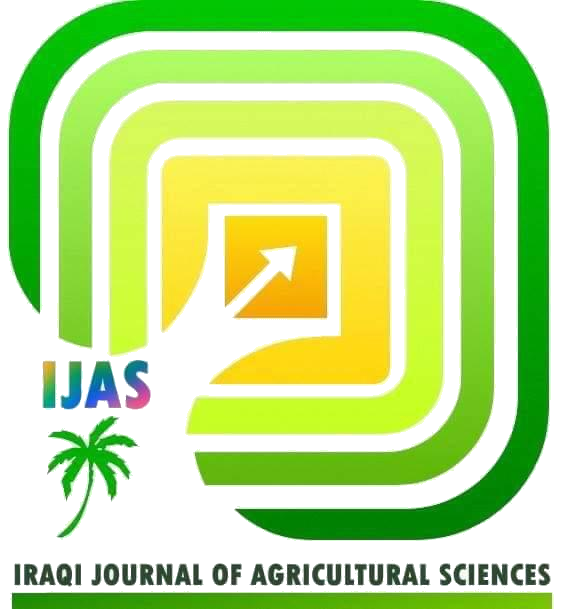RESPONSE OF SOME SYNTHETIC MAIZE CULTIVARS TO MINERAL, ORGANIC AND BIO FERTILIZER
DOI:
https://doi.org/10.36103/1hbcd595Keywords:
corn, organic, bio fertilizer, humic, sulfurAbstract
The objective of this study was to investigate the possibility of replacing part of mineral fertilizers, by organic or bio fertilizers and effect of these fertilizers on grain yield and its components of maize (Zea mays L.). Field experiment was conducted at Abu Ghraib Research Station (Baghdad) during spring and fall seasons of 2016 using a randomized complete block design arranged in split plot with three replications .Three synthetic varieties of maize (Fajr 1 , Baghdad 3 and Sumer) in the main plots and nine fertilizer treatments which were : 100% NPK as recommended , NPK + sulfur , NPK + organic fertilizer , NPK + Bio fertilizer, NPK + Humic acid ,50% NPK + sulfur ,50% NPK + organic fertilizer,50% NPK + Bio and50% NPK + Humic acid in the sub plots . The results showed that the varieties Baghdad 3 gave highest value for most yield components for both seasons. 100% NPK+ organic fertilizers was superior in grain yield and most components (No. of ears per plant, No. of rows per ear, No. of grain per row and grain yield) most the combination between Fajir 1 and 100%NPK + organic fertilizers gave the highest grain yield about 10.381 , 11.758 m h-1 respectively.
References
1. Adhikary,B. H., B.R. Baral, J. Shrestha and R. Adhikary .2015. Genotypes and fertilization influence on grain yield of winter maize, Int. J. of Agri. Sci, 5(5):844-848.
2. Al-Abodi, H. M. K.2010.Maize Response to Iirrigation, Planting Depth and Methods. Ph.D. Dissertation, Dept. of Field Crops Sci., Coll. Agric., Univ. Baghdad,(in Arabic) pp.130.
3. Al-Bahrani, I. Q. M.2015. Effect of Phosphate Soluble Bacteria and Humic Acid in Phosphorus Equilibrium, Nutrient Readiness and Maize (Zea mays L.).Ph.D. Dissertation, Coll. Agric., Univ. Baghdad, ( in Arabic) pp.155.
4. Al-Khafaji, H. H. A.2015. Effect of concentration and spraying date of humic acid on growth and yield of (Zea mays L.). Kufa J. for Agri. Sci., 7(1):155-170.
5. Amanullah and A. khan .2015. Phosphorus and compost management influence maize (Zea mays L.) productivity under semiarid condition with and without phosphate solubilizing bacteria. Int. J. bio. Sci., 6:1-8.
6. Buyukkeskin, T.and S. Akince. 2011. The effect of humic acid above ground parts of bean seedling under all toxicity. Fresennus Env.bull, 20(3):539-548.
7. Directorate of Agricultural Statistics. 2016. Production of Cotton, Maize and Potatoes. Central Statistical Organization. Ministry of Planning, Iraq. PP.19. http://www.cosit.gov.iq/ar/agri-stat/veg-prod.
8. El-Sahookie, M. M.2011.Instructions in planting corn. General Authority for Extension and Agricultural Cooperation. Ministry Of Agriculture. Iraq.( in Arabic) pp.7.
9. Humintech.2012. Its possible to replace Humus with organic manure. http://www.humintec.com/001/industry/information/foog/.hitml#top.
10. Hussein, H. T.2016. Effect of sulfur and vitamin C addition on yield components of corn (Zea mays L.) . Euphrates J. Agric. Sci., 8(2):190-200.
11. Jafari, A., F. P. jad and M. J. Al-ahmadi. 2009. Evaluation of selection indices for drought tolerance of corn (Zea mays L.) hybrids. Int. J. of Plant Pro., 3(4):33-38.
12. Majidian M., A. Ghalavand, N. Karimian, Kamkar and A. Haghighi.2006. Effects of water stress, nitrogen fertilizer and organic fertilizer in various farming systems in different growth stages on physiological characteristics, physical characteristics, quality and chlorophyll content of maize single cross hybrid 704. Iranian Crop Sciences, J. 10(3): 303-330.
13. Mnajid, M. H. and A. A.R. Oiyed .2013.Effect of addition of potassium fertilizer levels to soil and spraying of iron in growth and yield of corn (Zea mays L.). J. of Tikrit Univ. for Agri. Sci., 13(2):398-405.
14. Mohana, A. A., M. M. Suleiman and W. S. Khedr .2015. Effect of Humic Acid and Rates of Nitrogen Fertilizer on Yield and Yield Components of Corn (Zea mays L.) . Jordan J. in Agri. Sci.,11 (1):229-241.
15. Oluwaranti, A. and O. T. Ajani .2016. Evaluation of Drought Tolerant Maize Varieties under Drought and Rain-Fed Conditions: A Rainforest Location .J. of Agri. Sci., 8(7):9752-9760.
16. Sharifi, R. S. and T. hizaden.2009. Response of maize (Zea mays L.) cultivars of different levels of nitrogen fertilizer . J. of food Agri. Env., 7(3-4):518-521.
17. Verma, J. P.; J .Yadav; K. Tiwari; N.Lavakush and V. Singh.2010. Impact of plant growth promoting rhizobacteria on crop production. Int. J. Agric. Res., 954 – 983.
18. Wu, S. C.; Z.H. Cao; Z.G. Li; K.C. Cheung and M.H. Wong. 2005. Effect of bio fertilizer containing N .fixer, P and k solubilizers and AM fungi on maize growth: a greenhouse trial. Geoderma J., 125 (1-2): 155 -166.
19. Wuhaib, K. M. 2013. Harvest index and plant breeding. Iraqi J. of Agri. Sci., 44(2):168-193.
20. Wuhaib, K.M., H. K. AL-haidary and K.A. Makyia.2009. Split application nitrogen for (Zea Mays L.) genotypes to get the best sink. J. Tikrit Univ. for Agri. Sci., 9(1):104-116.
Downloads
Published
Issue
Section
License
Copyright (c) 2025 IRAQI JOURNAL OF AGRICULTURAL SCIENCES

This work is licensed under a Creative Commons Attribution-NonCommercial 4.0 International License.

2.jpg)
 https://orcid.org/0000-0002-5774-5906
https://orcid.org/0000-0002-5774-5906 



